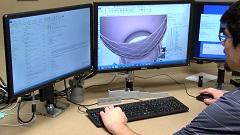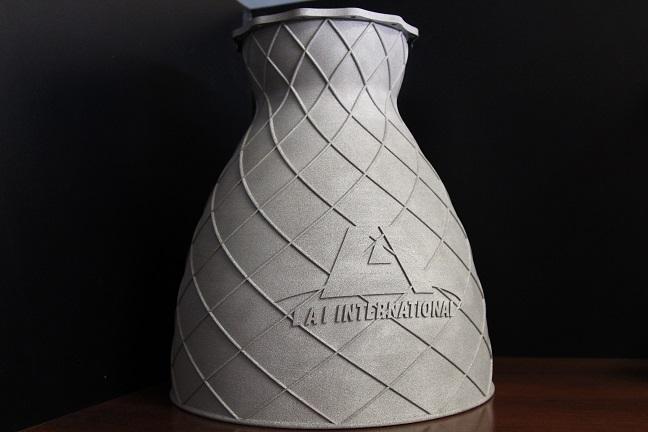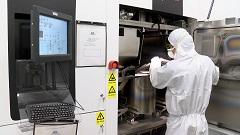- FMA
- The Fabricator
- FABTECH
- Canadian Metalworking
Our Publications
Categories
- Additive Manufacturing
- Aluminum Welding
- Arc Welding
- Assembly and Joining
- Automation and Robotics
- Bending and Forming
- Consumables
- Cutting and Weld Prep
- Electric Vehicles
- En Español
- Finishing
- Hydroforming
- Laser Cutting
- Laser Welding
- Machining
- Manufacturing Software
- Materials Handling
- Metals/Materials
- Oxyfuel Cutting
- Plasma Cutting
- Power Tools
- Punching and Other Holemaking
- Roll Forming
- Safety
- Sawing
- Shearing
- Shop Management
- Testing and Measuring
- Tube and Pipe Fabrication
- Tube and Pipe Production
- Waterjet Cutting
Industry Directory
Webcasts
Podcasts
FAB 40
Advertise
Subscribe
Account Login
Search
LAI International adds additive manufacturing to its toolbox
Company sees it as a natural addition to high-tech processes already in place
- By Sue Roberts
- July 6, 2018
- Article
- Additive Manufacturing

Figure 1. Intermediate dimensional checks ensure conformance to requirements before additional post-processing steps commence. Photos courtesy of LAI International.
LAI International’s established pattern of growth is seen both in the addition of facilities placed throughout the U.S. and the adoption of fabricating and machining technologies.
Laser Applications Inc. (LAI), founded by Robert Ulrich in 1979, initially offered laser welding and laser heat-treating processes. Waterjet, laser drilling, and cutting capabilities soon were added, along with facilities in Westminster, Md., Minneapolis, Minn., and its headquarters in Tempe, Ariz.
Rich Technology International in Scarborough, Maine, a contract manufacturer that served the aerospace, medical, power generation, and electronic sectors, became part of the LAI family in 2007.
RLJ Equity Partners purchased LAI in 2012. The firm added Zak Inc., a shop providing contract manufacturing in Troy, N.Y., since 1937, in 2014.
Throughout the growth of the manufacturing network, the focus remained the same—produce complex, highly engineered, precision components on time and at and equitable price. That strategy continues to gain the company recognition. Among its most recent achievements are inclusion on Inc. magazine’s 5,000 list of fastest-growing U.S. private companies; a Northrup Grumman Platinum Supplier Preferred Award; and an Arizona Corporate Excellence (ACE) Award.
The facilities spanning the U.S. have redundant production equipment to ensure availability for key programs as well as unique technical capabilities. Processes include 5-axis turning, milling, horizontal machining, and polishing; 5-axis EDM, laser, and waterjet cutting; certified special processes such as assembly, die cutting, laser heat treating and welding, gas metal arc welding, gas tungsten arc welding, and electron-beam welding, and shot peening; and the newest addition, metal additive manufacturing.
The LAI acronym has taken on a new meaning to reflect the expanded company. It stands for Leading Advanced Innovations.
A Logical Step
Adding AM in 2015 was viewed as a natural expansion of the high-tech processes already in place. It helped attract more work from aerospace and defense customers which currently make up nearly 80 percent of the customer base.
Caitlin Oswald, AM director, was brought in to help build the department from the ground up. Her master’s degree in mechanical engineering, coupled with several years of experience with AM at UTC Pratt and Whitney, gave her a unique perspective.
“Embracing additive was a natural opportunity for the company to grow. LAI was already doing a lot of complex work, and some of its customers were struggling to find an additive supplier. The industry had companies that knew additive but didn’t necessarily have an aerospace background. And there were aerospace suppliers that didn’t have a lot of experience with additive. LAI invested in the technology and the resources to bring aerospace experience and additive technology together to fill that niche.

Figure 2. Full design capability and manufacturing engineering support is provided for all additive programs.
“My colleague, Adam Rivard, and I designed the department with the capabilities I would have liked to have available from an AM supplier when I was on the aerospace side.”
It took about six months to learn the specifics of the equipment, develop production systems, and write standards. The Arizona plant, in addition to its conventional machining and fabricating capabilities, became the company’s Center of Excellence for AM with a large area dedicated to AM post-production.
“Post-production can include several processes. We usually see some level of thermal treatment—hot isostatic pressing—which helps seal potential internal indications. Then once you have your near net shape, there is usually some type of surface finishing and perhaps machining to create critical features. When production is complete, the part moves on to inspection and testing [see Figure 1] to ensure the internal and external qualities. That stage might involve witness coupons that are built along with the part for tensile testing, it might be a CT scan for extremely critical products, or it might be an X-ray. The type of testing used depends on the component.”
LAI was the first company to achieve National Aerospace and Defense Contractors Accreditation Program’s (NADCAP) accreditation for AM.
“The checklist for achieving this certification was released towards the end of 2016,” Oswald said. “We achieved the very first accreditation by the spring of 2017 and have just completed our recertification.”
“We are very proud of being the first in the world to have been accredited in this area,” she continued. “It’s a real testament to the strong process control, standards, and systems that we have in place. This accreditation assures customers that they are going to get a certain quality of work when we produce an AM component for them.”
Standards and Validation
Work on developing AM procedures and company and industry specifications is on-going. SAE International’s AMS7003 specifications for laser powder bed fusion processes was written for use while producing aerospace parts from metal alloys and released in early June 2018. It was authored by Rivard.
“We are very involved in the specifications community,” said Oswald. “Our involvement allows us to use our experience to influence the standards and we learn from the other experts, which helps us make sure our processes are up to expectations.”
An integrated product team dedicated to ensuring the best customer service and production flow is an integral part of the company’s procedures. The team follows the manufacturing process from beginning to end.
“We incorporate our manufacturing engineers all the way through the post-processing,” said Oswald. “The focus is on understanding the entire value stream. If we were just printing the part as the 3-D model spits it out, the opportunity for efficiencies in tooling would be lost, or we might not identify where stock should be added to support critical surface features … things like that. All of these aspects are discussed before beginning production.”

Figure 3. A large nozzle was built to demonstrate the size potential of LAI’s electron beam powder bed fusion technology.
LAI developed a software that creates a 3-D model of the entire component while it is being built to help meet some stringent validation requirements (see Figure 2). Oswald explained how it works: “Additive equipment comes with a camera that takes photos of every layer as it is built. Our software takes those images and builds a file that we can use to identify any issues once the build is complete. We can immediately understand what the CT scan is going to look like.”
For now, this software, called TIRA (Thermal Image Rendering & Analysis), is available only for LAI customers. In the future it may be offered as an engineering service.
Different Customer Interactions
Interactions with the company’s additive customers are a bit more complex than those with customers from the conventional manufacturing realm.
Oswald said, “Working with an additive customer is a much longer journey than working with a traditional manufacturing customer where we get a print, create a quote, and either win or lose the job. With additive we deal with whether or not parts will physically work, plus material and process changes to existing products. Those changes bring on a lot of new insights on the customer side as designers learn how to design for the additive process.
“We find it is easiest to start small with a new additive customer, do some development work to gain an understanding of how our teams can work together, and then expand into finding the right parts for the appropriate additive technology production,” she explained.
Three different types of metal AM technologies are available: directed energy deposition, electron beam powder bed fusion (see Figure 3), and laser powder bed fusion.
The application guides the process choice. “An internal selection process helps us work with our customers to select the most efficient material, process, and machine combinations for their additive candidates,” Oswald said. “And customers are learning how to qualify an additive supplier and determine whether using additive will provide a savings or be cost-neutral.”
AM has taken hold as an integral part of the company’s offerings (see Figure 4) and is expected to grow along with the conventional manufacturing processes. As the technology expands—additive machine manufacturers are pushing the boundaries to produce larger parts, increase speeds, and offer hybrid machines; new materials are being developed and the cost of powders are coming down; and engineers are becoming experts in the technology—shops are evaluating which AM processes make sense to add to their tool box.
Oswald said, “Additive still represents a large investment. I don’t know where the prices of machines will go, but as the equipment becomes more robust, and an experienced talent pool grows, it will be easier for the small and mid-sized fabricating shops to justify adding this technology to their production options. It will become a little more plug-and-play … a little easier.”
About the Author

About the Publication
Related Companies
- Podcasting
- Podcast:
- The Fabricator Podcast
- Published:
- 04/30/2024
- Running Time:
- 53:00
Seth Feldman of Iowa-based Wertzbaugher Services joins The Fabricator Podcast to offer his take as a Gen Zer...
- Trending Articles
- Industry Events
Pipe and Tube Conference
- May 21 - 22, 2024
- Omaha, NE
World-Class Roll Forming Workshop
- June 5 - 6, 2024
- Louisville, KY
Advanced Laser Application Workshop
- June 25 - 27, 2024
- Novi, MI
Precision Press Brake Certificate Course
- July 31 - August 1, 2024
- Elgin,



























